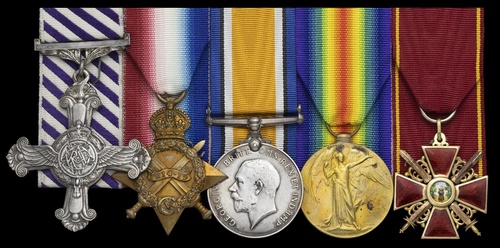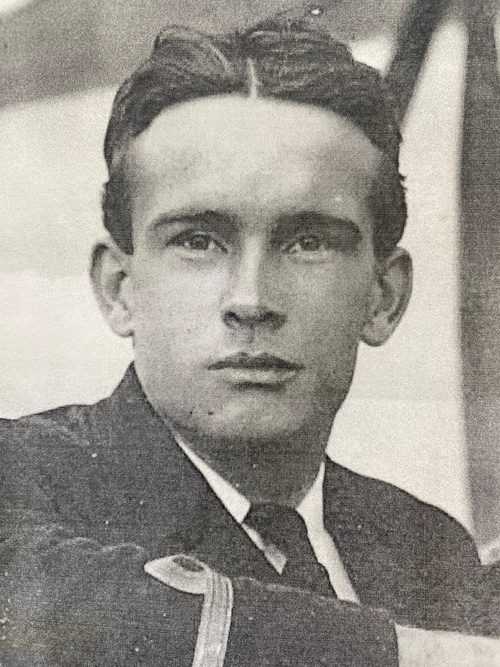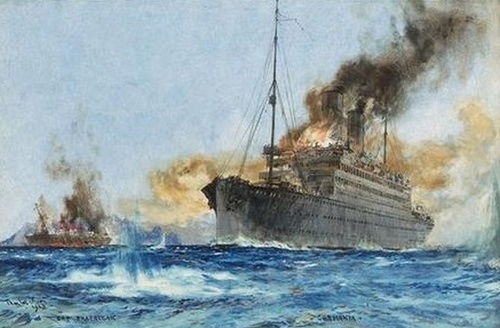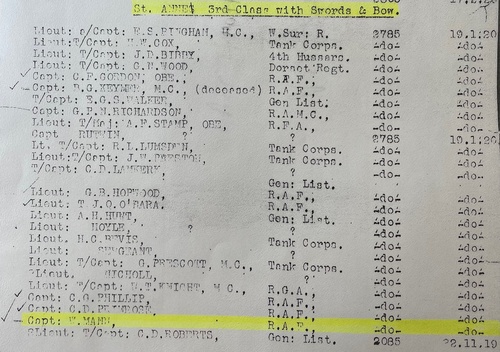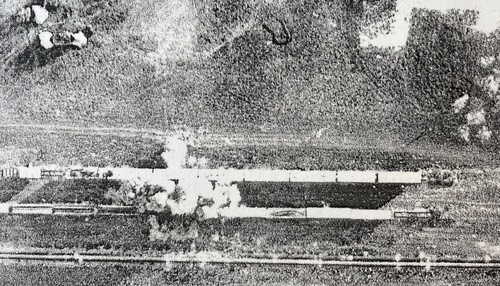Auction: 25001 - Orders, Decorations and Medals
Lot: 311
A Great War ‘Adriatic Operations’ D.F.C. and Order of St Anne with Swords group of five awarded to Major W. Man, Royal Air Force, late Royal Naval Air Service and Royal Naval Reserve, a most able Seaplane Pilot
Man had been present for the fierce engagement in the South Atlantic between the Carmania and the Cap Trafalgar on 14 September 1914 - the first battle in history between converted ocean liners - and went on to share in several hot actions in seaplanes, notably at the El Afulch rail junction
Distinguished Flying Cross, G.V.R., unnamed as issued; 1914-15 Star (S. Lt. W. Man, R.N.R.); British War and Victory Medals (Capt. W. Man. R.A.F.); Russia, Empire, Order of St. Anne, Third Class breast Badge, with swords, by Keibel, St. Petersburg, gold (56 zolotniki) and enamel, marker’s mark and court stamp to reverse, gold mark to suspension ring, sword piece in upper-right angle repaired, otherwise very fine (5)
Approximately 47 Order of St. Anne 3rd Class with Swords issued, 8 in combination with the D.F.C.
D.F.C. London Gazette 3 June 1918.
Research at The National Archives on non-Gazetted Russian awards states the Ministry of Defence (Air) had confirmed the D.F.C. was awarded for services in the Adriatic and also stating confirmation of his entitlement to the Russian Order of St. Anne 3rd Class with Swords & Bow.
William Man was born on 10 March 1891 at Cottingham, Yorkshire, son of Commander T. Man, R.N., C.O. Maritime Buildings, Southampton. Young Man took his Apprentices Indenture in 1907, and joined the Australasian Branch of the Royal Naval Reserve as a Midshipman on 1 January 1910. He received a Certificate of Competency as Second Mate in a foreign going ship on 17 May 1912 and on the Isis and Devonshire that year.
Following the outbreak of the Great War, he was assigned on 6 August 1914 to the Armed Merchant Cruiser R.M.S. Carmania as Midshipman from 6 August-14 September 1914 and Acting Sub. Lieutenant from 14 September 1914 until 30 June 1915.
He quickly saw action, being present at the Battle of Trinidade, the world's first battle between former ocean liners. Here, the Carmania engaged and sank the German merchant cruiser S.M.S. Cap Trafalgar in a furious action in the South Atlantic on 14 September 1914. The circumstances are described in vivid detail by The Illustrated War News on 18 November 1914:
'Both the captains of the Cap Trafalgar and the Carmania had realised that to fight a successful action, their respective vessels required plenty of room; so, the captains had separately steamed several miles from the outcrop of Trindade in order to gain the space required. The Cap Trafalgar also sent out encoded German messages, announcing the engagement with the Carmania, and the position as 35 degrees west, 26 degrees south, with a NNW heading. Then the two ships turned towards each other and began to fight, the Carmania firing too early and thus allowing the Cap Trafalgar to land the first blow.
Carmania fared worse than her opponent in the ensuing two hours, being hit 79 times, was holed beneath the waterline, and had her bridge totally destroyed by shellfire. However, as the range closed, her own guns began to inflict damage, and fires broke out on both ships, sailors lining the rails and firing machine guns at their opposite numbers as the ships came within a few hundred yards of each other. Neither ship had the fire control systems or ammunition hoists of a modern warship, so the action was fought in the style of Nelson's day, with ammunition being brought to the guns by hand and the guns firing as the target bore.'
Veering away, the Cap Trafalgar heeled over to port and was forced to lower her lifeboats. A shell below the waterline had ruptured several compartments and she began to sink fast. Things were little better aboard Carmania; she listed severely as fires burned and destroyed the navigation and communication equipment on her bridge. Aware of the presence of other enemy vessels in the area, notably the Kronprinz Wilhelm, captain Noel Grant gave the order to turn away and head south, hoping to rendezvous with a British cruiser. By the time she was rescued the following day, Carmania was barely seaworthy and was slowly escorted into Pernambuco by the Royal Navy. Meanwhile the 279 survivors of the Cap Trafalgar were rescued by the collier Eleonore Woermann and taken to Buenos Aires. Most were later interned on the Argentine island of Martin Garcia. (The Hamburg South America Line, refers).
Midshipman Man received his promotion to Acting Sub-Lieutenant on that day (possibly promoted for this event) and held that rank until 30 June 1915, being transferred to the Royal Naval Air Service in the rank of Flight Sub-Lieutenant, firstly at Whale Island, before taking his Royal Aero Club Aviators' Certificate on 6 November 1915 (No. 1996) at the Graham-White School, Hendon, on a Graham-White Biplane, then serving at Chingford and Calshot.
He served in the three seaplane carriers of the East Indies and Egypt Seaplane Squadrons for April-August 1916 were Ben-my-Chree April, May, June & September 1916, Raven II July & December 1916 and Anne in August 1916.
On 15 February 1916 he transferred to Egypt aboard Raven II and on 29 June 1916 suffered water in a float, being unable to take off and was beached at Tersana Bay, being returned to ship by the trawler Laborieux and then on 12 July 1916 when flying Sopwith Schneider No. 3786 suffered a total loss whilst doing reconnaissance of the Syrian Coast (engine failure). Man's Schneider was found by seaplane 8091 in a sinking condition with Man standing on the upper mainplane clear of the water. A crowd on the beach had formed, but no attempt was made by them to open fire or board the machine. Dacre landed close to the Schneider and Man swam across to the Short seaplane and the Schneider was finished off with a full hopper by Brown the Observer with the lewis gun from the Short, as being near a hostile coast (½ mile off Acre, Palestine) it was impossible to salve any part of the machine. With Man in the Observers seat and Brown sitting astride the top petrol tank to balance the seaplane they returned to Raven II.
With his service in August on Anne they spotted the fall of shot for Pothuau on a factory North East of Mersina. He also flew the Schneider on anti submarine patrols with two 16lb bombs. On the 21 August Samson met Admiral Wemyss with a plan to attack with his limited resources the Turkish communications at El Afulch Junction. The three seaplane carriers put up three Shorts and two Babys from Ben-my-Chree, from Anne one Short and Schneider 3777 piloted by Man, two Shorts and one Baby from Raven. His objective was the buildings and stores of the station. After bombing the single-seaters were to protect the Shorts from enemy aircraft. Anne's machines opened the attack on the junction, Man dropping a line of bombs across the station buildings. Within fifteen minutes the raid was over. Thirteen 65lb and 112lb bombs and 31 smaller bombs had been dropped. The station buildings were left burning, a locomotive and 14 carriages and trucks were destroyed or damaged and an unknown quantity of stores burned or destroyed. Anti-aircraft fire throughout the attack had been heavy, two guns in the station yard being particularly troublesome. An hour later two Shorts returned to access the damage to find fires still burning, the permanent way South of the junction was completely wrecked with rails uprooted and embankment destroyed. Sampson in his report concluded:
'It may be assumed that the junction and South going line will not be in operation for some time.'
Prisoners of War said the raid had shut down rail traffic for five days. Later that week two planes from Anne with Man in Baby 3777 again flew down the coast, following the railway to Wadi El Hesi, where the track crossed the wadi by a viaduct. Both machines dropped bombs, which damaged the track but failed to hit the bridge structure.
He Ben-my-Chree at Port Said. From Over the Front (Volume 13 No. 1, pages 25-26):
'The German view - A combined seaplane and ship artillery attack by two aircraft carriers (HMS Ben-my-Chree & Raven II), the sloop Espiegle and the monitors M.15 and M.31 was launched on El Arish on 17th September at 0524 hrs. with six seaplanes taking part. Two Shorts were to direct the gunfire and observe the area with four Sopwith aircraft as escorts. The absence of coastal defences must have been reported to the British by their spies. This Sea Battle of El Arish was also described by Hptm. Felmy. Ltne von Bulow and von Hesler, still in their pyjamas, shot down one seaplane in flames (Sopwith Baby 8135 from HMS Ben-my-Chree). The pilot Lt. J.T. Bankes-Price RNAS was killed. They forced also Sopwith Schneider 3777 with pilot F.S.Lt. W. Man, RNAS, to alight on the water. The pilot was rescued but his seaplane sank. Remainders of the planes were washed up on the beach near Sheikh Zowaiid the next day and were picked up by Gefr. Block with a car.
The British view of this action - On 17 September 1916 while escorting 8372 spotting for H.M.S Espiegle, flying his Schneider 3777, whose objective was El Arish to Bir El Mazar Road, Man was shot down by A.A. guns near El-Arish, Syria and his Sopwith Schneider No.3777 force landed on the sea, chassis collapsed, machine overturned and sank. Flt. Sub. Lieut. Man was picked up by S.T. Ronania.'
Man was advanced Flight Lieutenant on 31 December 1916 and joined No. 6 Wing in March 1917. He returned to England on 22 December 1917, suffering with malaria and had only made a recovery by May 1918, having been made Temporary Flight Commander on 1 January 1918. Subsequently transferred to the Royal Air Force on its formation in April 1918, he was sent to Houton Bay. On 13 July 1918, flying a Felixstowe F.3 Patrol Tractor Biplane Flying Boat, Man and Lieutenant W. M. Shoesmith, flying from Kirkwall dropped two bombs on a 'U' boat.
It was this action that Man thought he was awarded his D.F.C. (see below note from daughter) for sinking a submarine when he was stationed in the Shetland Islands, but this has been recently confirmed by the Ministry of Defence (Air) that it was for services in the Adriatic. His Service Record states:
'Shown exceptional regard and devotion to duty, while employed at Otranto, continually flew while suffering from malaria.'
The January 1919 Navy List shows man as a Captain, D.F.C. in the Royal Air Force based in Shetland while still retaining his rank of Acting Sub-Lieutenant in the Royal Naval Reserve. He was however, granted a short service commission in the Royal Air Force in the rank of Flight Lieutenant with effect from 24 October 1919 and his name would be removed from the list of officers of the Royal Naval Reserve with effect also from this date.
Resigning his commission with effect from 8 December 1921, he retained the rank of Major. By 1939, Man was listed as a Wing Commander.
A typed note, which accompanies the Lot states:
'This D.F.C. belonged to my father William Man and was awarded in the First World War for sinking a submarine when he was stationed in the Shetland Islands, as far as I remember.
He was in the R.N.A.S. and joined the R.A.F. when it was formed. He went to New Zealand in about 1925 and at one time operated an air service between Auckland and Fiji and Auckland until their flying boat (A Dornier I think) crashed in Auckland Harbour. When the R.N.Z.A.F. was formed by Air Vice Marshall Ralf Cockrane, he was Personnel Officer. In December 1938 he resigned and returned to England and joined the R.A.F.V.R. and was stationed in Newcastle and Thornaby. William Man died in 1976.'
Sold together with a good quantity of copied research, including TNA listing of Russian St Anne 3rd Class with Swords & Bow, Aviators' Certificate, 2nd Mate Certificate, Service Records and the articles Operations by the 2 Seaplane Carriers of East Indies & Egypt Seaplane Sqd. April-Aug. 1916 & Wings Over Sinai & Palestine.
Subject to 20% VAT on Buyer’s Premium. For more information please view Terms and Conditions for Buyers.
Estimate
£5,000 to £6,000
Starting price
£4800

